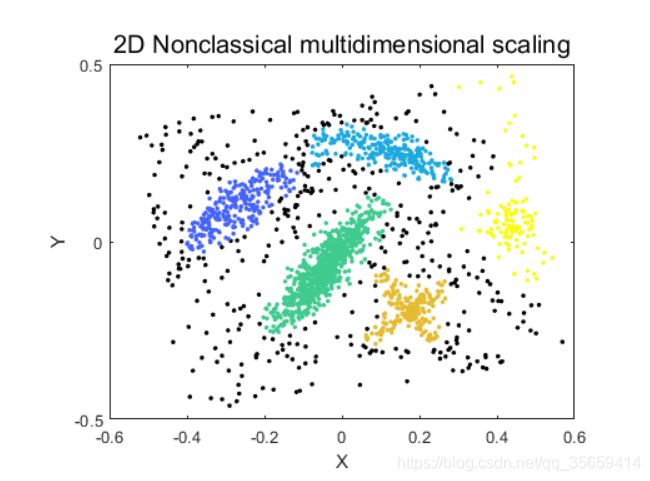密度峰值聚类算法(DPC)
密度峰值聚类算法(DPC)
1. 简介
基于密度峰值的聚类算法全称为基于快速搜索和发现密度峰值的聚类算法(clustering by fast search and find of density peaks, DPC)。它是2014年在Science上提出的聚类算法,该算法能够自动地发现簇中心,实现任意形状数据的高效聚类。
该算法基于两个基本假设:1)簇中心(密度峰值点)的局部密度大于围绕它的邻居的局部密度;2)不同簇中心之间的距离相对较远。为了找到同时满足这两个条件的簇中心,该算法引入了局部密度的定义。



基于快速搜索和发现密度峰值的聚类算法,想法非常直观,能够快速发现密度峰值点,并能够高效进行样本分配和发现噪声点。同时,因为该方法非常适用于大规模数据的聚类分析,因此具有很好的研究价值和应用前景。
2. MATLAB程序
// An highlighted block
clear all
close all
disp('The only input needed is a distance matrix file')
disp('The format of this file should be: ')
disp('Column 1: id of element i')
disp('Column 2: id of element j')
disp('Column 3: dist(i,j)')
%% 从文件中读取数据
mdist=input('name of the distance matrix file\n','s');
disp('Reading input distance matrix')
xx=load(mdist);
ND=max(xx(:,2));
NL=max(xx(:,1));
if (NL>ND)
ND=NL; %% 确保 DN 取为第一二列最大值中的较大者,并将其作为数据点总数
end
N=size(xx,1); %% xx 第一个维度的长度,相当于文件的行数(即距离的总个数)
%% 初始化为零
for i=1:ND
for j=1:ND
dist(i,j)=0;
end
end
%% 利用 xx 为 dist 数组赋值,注意输入只存了 0.5*DN(DN-1) 个值,这里将其补成了满矩阵
%% 这里不考虑对角线元素
for i=1:N
ii=xx(i,1);
jj=xx(i,2);
dist(ii,jj)=xx(i,3);
dist(jj,ii)=xx(i,3);
end
%% 确定 dc
percent=2.0;
fprintf('average percentage of neighbours (hard coded): %5.6f\n', percent);
position=round(N*percent/100); %% round 是一个四舍五入函数
sda=sort(xx(:,3)); %% 对所有距离值作升序排列
dc=sda(position);
%% 计算局部密度 rho (利用 Gaussian 核)
fprintf('Computing Rho with gaussian kernel of radius: %12.6f\n', dc);
%% 将每个数据点的 rho 值初始化为零
for i=1:ND
rho(i)=0.;
end
% Gaussian kernel
for i=1:ND-1
for j=i+1:ND
rho(i)=rho(i)+exp(-(dist(i,j)/dc)*(dist(i,j)/dc));
rho(j)=rho(j)+exp(-(dist(i,j)/dc)*(dist(i,j)/dc));
end
end
%
% "Cut off" kernel
%
%for i=1:ND-1
% for j=i+1:ND
% if (dist(i,j)<dc)
% rho(i)=rho(i)+1.;
% rho(j)=rho(j)+1.;
% end
% end
%end
%% 先求矩阵列最大值,再求最大值,最后得到所有距离值中的最大值
maxd=max(max(dist));
%% 将 rho 按降序排列,ordrho 保持序
[rho_sorted,ordrho]=sort(rho,'descend');
%% 处理 rho 值最大的数据点
delta(ordrho(1))=-1.;
nneigh(ordrho(1))=0;
%% 生成 delta 和 nneigh 数组
for ii=2:ND
delta(ordrho(ii))=maxd;
for jj=1:ii-1
if(dist(ordrho(ii),ordrho(jj))<delta(ordrho(ii)))
delta(ordrho(ii))=dist(ordrho(ii),ordrho(jj));
nneigh(ordrho(ii))=ordrho(jj);
% 记录 rho 值更大的数据点中与 ordrho(ii) 距离最近的点的编号 ordrho(jj)
end
end
end
%% 生成 rho 值最大数据点的 delta 值
delta(ordrho(1))=max(delta(:));
%% 决策图
disp('Generated file:DECISION GRAPH')
disp('column 1:Density')
disp('column 2:Delta')
fid = fopen('DECISION_GRAPH', 'w');
for i=1:ND
fprintf(fid, '%6.2f %6.2f\n', rho(i),delta(i));
end
%% 选择一个围住类中心的矩形
disp('Select a rectangle enclosing cluster centers')
%% 每台计算机,句柄的根对象只有一个,就是屏幕,它的句柄总是 0
%% >> scrsz = get(0,'ScreenSize')
%% scrsz =
%% 1 1 1280 800
%% 1280 和 800 就是你设置的计算机的分辨率,scrsz(4) 就是 800,scrsz(3) 就是 1280
scrsz = get(0,'ScreenSize');
%% 人为指定一个位置
figure('Position',[6 72 scrsz(3)/4. scrsz(4)/1.3]);
%% ind 和 gamma 在后面并没有用到
for i=1:ND
ind(i)=i;
gamma(i)=rho(i)*delta(i);
end
%% 利用 rho 和 delta 画出一个所谓的“决策图”
subplot(2,1,1)
tt=plot(rho(:),delta(:),'o','MarkerSize',5,'MarkerFaceColor','k','MarkerEdgeColor','k');
title ('Decision Graph','FontSize',15.0)
xlabel ('\rho')
ylabel ('\delta')
fig=subplot(2,1,1);
rect = getrect(fig);
%% getrect 从图中用鼠标截取一个矩形区域, rect 中存放的是
%% 矩形左下角的坐标 (x,y) 以及所截矩形的宽度和高度
rhomin=rect(1);
deltamin=rect(2); %% 作者承认这是个 error,已由 4 改为 2 了!
%% 初始化 cluster 个数
NCLUST=0;
%% cl 为归属标志数组,cl(i)=j 表示第 i 号数据点归属于第 j 个 cluster
%% 先统一将 cl 初始化为 -1
for i=1:ND
cl(i)=-1;
end
%% 在矩形区域内统计数据点(即聚类中心)的个数
for i=1:ND
if ( (rho(i)>rhomin) && (delta(i)>deltamin))
NCLUST=NCLUST+1;
cl(i)=NCLUST; %% 第 i 号数据点属于第 NCLUST 个 cluster
icl(NCLUST)=i; %% 逆映射,第 NCLUST 个 cluster 的中心为第 i 号数据点
end
end
fprintf('NUMBER OF CLUSTERS: %i \n', NCLUST);
disp('Performing assignation')
%assignation
%% 将其他数据点归类 (assignation)
for i=1:ND
if (cl(ordrho(i))==-1)
cl(ordrho(i))=cl(nneigh(ordrho(i)));
end
end
%halo
%% 由于是按照 rho 值从大到小的顺序遍历,循环结束后, cl 应该都变成正的值了.
%% 处理光晕点,halo这段代码应该移到 if (NCLUST>1) 内去比较好吧
for i=1:ND
halo(i)=cl(i);
end
if (NCLUST>1)
% 初始化数组 bord_rho 为 0,每个 cluster 定义一个 bord_rho 值
for i=1:NCLUST
bord_rho(i)=0.;
end
% 获取每一个 cluster 中平均密度的一个界 bord_rho
for i=1:ND-1
for j=i+1:ND
%% 距离足够小但不属于同一个 cluster 的 i 和 j
if ((cl(i)~=cl(j))&& (dist(i,j)<=dc))
rho_aver=(rho(i)+rho(j))/2.; %% 取 i,j 两点的平均局部密度
if (rho_aver>bord_rho(cl(i)))
bord_rho(cl(i))=rho_aver;
end
if (rho_aver>bord_rho(cl(j)))
bord_rho(cl(j))=rho_aver;
end
end
end
end
%% halo 值为 0 表示为 outlier
for i=1:ND
if (rho(i)<bord_rho(cl(i)))
halo(i)=0;
end
end
end
%% 逐一处理每个 cluster
for i=1:NCLUST
nc=0; %% 用于累计当前 cluster 中数据点的个数
nh=0; %% 用于累计当前 cluster 中核心数据点的个数
for j=1:ND
if (cl(j)==i)
nc=nc+1;
end
if (halo(j)==i)
nh=nh+1;
end
end
fprintf('CLUSTER: %i CENTER: %i ELEMENTS: %i CORE: %i HALO: %i \n', i,icl(i),nc,nh,nc-nh);
end
cmap=colormap;
for i=1:NCLUST
ic=int8((i*64.)/(NCLUST*1.));
subplot(2,1,1)
hold on
plot(rho(icl(i)),delta(icl(i)),'o','MarkerSize',8,'MarkerFaceColor',cmap(ic,:),'MarkerEdgeColor',cmap(ic,:));
end
subplot(2,1,2)
disp('Performing 2D nonclassical multidimensional scaling')
Y1 = mdscale(dist, 2, 'criterion','metricstress');
plot(Y1(:,1),Y1(:,2),'o','MarkerSize',2,'MarkerFaceColor','k','MarkerEdgeColor','k');
title ('2D Nonclassical multidimensional scaling','FontSize',15.0)
xlabel ('X')
ylabel ('Y')
for i=1:ND
A(i,1)=0.;
A(i,2)=0.;
end
for i=1:NCLUST
nn=0;
ic=int8((i*64.)/(NCLUST*1.));
for j=1:ND
if (halo(j)==i)
nn=nn+1;
A(nn,1)=Y1(j,1);
A(nn,2)=Y1(j,2);
end
end
hold on
plot(A(1:nn,1),A(1:nn,2),'o','MarkerSize',2,'MarkerFaceColor',cmap(ic,:),'MarkerEdgeColor',cmap(ic,:));
end
%for i=1:ND
% if (halo(i)>0)
% ic=int8((halo(i)*64.)/(NCLUST*1.));
% hold on
% plot(Y1(i,1),Y1(i,2),'o','MarkerSize',2,'MarkerFaceColor',cmap(ic,:),'MarkerEdgeColor',cmap(ic,:));
% end
%end
faa = fopen('CLUSTER_ASSIGNATION', 'w');
disp('Generated file:CLUSTER_ASSIGNATION')
disp('column 1:element id')
disp('column 2:cluster assignation without halo control')
disp('column 3:cluster assignation with halo control')
for i=1:ND
fprintf(faa, '%i %i %i\n',i,cl(i),halo(i));
end
3. 结果
>> cluster_dp
The only input needed is a distance matrix file
The format of this file should be:
Column 1: id of element i
Column 2: id of element j
Column 3: dist(i,j)
name of the distance matrix file
example_distances.dat
Reading input distance matrix
average percentage of neighbours (hard coded): 2.000000
Computing Rho with gaussian kernel of radius: 0.033000
Generated file:DECISION GRAPH
column 1:Density
column 2:Delta
Select a rectangle enclosing cluster centers
NUMBER OF CLUSTERS: 5
Performing assignation
CLUSTER: 1 CENTER: 149 ELEMENTS: 378 CORE: 260 HALO: 118
CLUSTER: 2 CENTER: 451 ELEMENTS: 326 CORE: 250 HALO: 76
CLUSTER: 3 CENTER: 1310 ELEMENTS: 884 CORE: 785 HALO: 99
CLUSTER: 4 CENTER: 1349 ELEMENTS: 297 CORE: 208 HALO: 89
CLUSTER: 5 CENTER: 1579 ELEMENTS: 115 CORE: 115 HALO: 0
Performing 2D nonclassical multidimensional scaling
Generated file:CLUSTER_ASSIGNATION
column 1:element id
column 2:cluster assignation without halo control
column 3:cluster assignation with halo control

